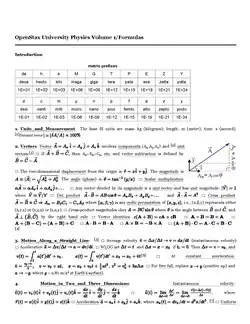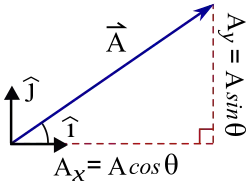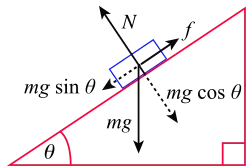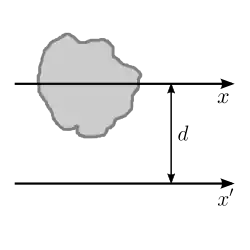OpenStax University Physics/V1/Formulas (master)

Introduction:
| da | h | k | M | G | T | P | E | Z | Y |
| deca | hecto | kilo | mega | giga | tera | peta | exa | zetta | yotta |
| 1E+01 | 1E+02 | 1E+03 | 1E+06 | 1E+09 | 1E+12 | 1E+15 | 1E+18 | 1E+21 | 1E+24 |
| d | c | m | µ | n | p | f | a | z | y |
| deci | centi | milli | micro | nano | pico | femto | atto | zepto | yocto |
| 1E-01 | 1E-02 | 1E-03 | 1E-06 | 1E-09 | 1E-12 | 1E-15 | 1E-18 | 1E-21 | 1E-24 |
1. Units_and_Measurement:
The base SI units are mass: kg (kilogram); length: m (meter); time: s (second). [1]
Percent error is

2. Vectors: Vector involves components (Ax,Ay,Az) and [2] unit vectors.[3] ▭ If , then Ax+Bx=Cx, etc, and vector subtraction is defined by .
▭ The two-dimensional displacement from the origin is . The magnitude is . The angle (phase) is . ▭ Scalar multiplication ▭ Any vector divided by its magnitude is a unit vector and has unit magnitude: where ▭ Dot product and ▭ Cross product where is any cyclic permutation of , i.e., (α,β,γ) represents either (x,y,z) or (y,z,x) or (z,x,y). ▭ Cross-product magnitudes obey where is the angle between and , and by the right hand rule. ▭ Vector identities ▭ ▭ ▭ ▭ ▭ [4]
3. Motion_Along_a_Straight_Line: [5] ▭ Average velocity (instantaneous velocity) ▭ Acceleration . ▭ WLOG set and if . Then , and , [6] ▭ At constant acceleration: . ▭ For free fall, replace (positive up) and , where = 9.81 m/s2 at Earth's surface).
4. Motion_in_Two_and_Three_Dimensions: Instantaneous velocity: ▭ , where ▭ Acceleration , where . [7] ▭ Uniform circular motion: position , velocity , and acceleration : Note that if then where . [8] ▭ Relative motion: [9] , [10]
5. Newton's_Laws_of_Motion: [11], where is momentum, [12] is the sum of all forces This sum needs only include external forces [13].[14]

▭ Weight. ▭ normal force[15] [16] ▭ [17] where is the spring constant.
6. Applications_of_Newton's_Laws: : friction, coefficient of (static,kinetic) friction, normal force. ▭ Centripetal force for uniform circular motion. Angular velocity is measured in radians per second. [18]▭ Drag equation where Drag coefficient, mass density, area, speed. Holds approximately for large Reynold's number[19]
7. Work_and_Kinetic_Energy: Infinitesimal work[20] leads to the path integral ▭ Work done from A→B by friction gravity and spring ▭ Work-energy theorem: [21] where kinetic energy . ▭ Power.
8. Potential_Energy_and_Conservation_of_Energy: Potential Energy: ; PE at WRT is (gravitational PE Earth's surface. (ideal spring) ▭ Conservative force: . In 2D, is conservative if and only if ▭ Mechanical energy is conserved if no non-conservative forces are present:
9. Linear_Momentum_and_Collisions: is momentum. ▭ Impulse-momentum theorem . ▭ For 2 particles in 2D where (α,β)=(x,y) ▭ Center of mass: , and ▭ [22]
10. Fixed-Axis_Rotation:


is angle in radians, is angular velocity; ▭ is tangential speed. Angular acceleration is . is the tangential acceleration. ▭ Constant angular acceleration is average angular velocity. ▭ ▭ ▭ Total acceleration is centripetal plus tangential: ▭ Rotational kinetic energy is where is the Moment of inertia. ▭ parallel axis theorem ▭ Restricting ourselves to fixed axis rotation, is the distance from a fixed axis; the sum of torques, requires only one component, summed as . ▭ Work done by a torque is . The Work-energy theorem is . ▭ Rotational power .
11. Angular_Momentum: Center of mass (rolling without slip) ▭ Total angular momentum and net torque: for a single particle. ▭ Precession of a top
12. Static_Equilibrium_and_Elasticity: Equilibrium Stress = elastic modulus · strain (analogous to Force = k · Δ x ) ▭ (Young's , Bulk , Shear) modulus:
13. Gravitation: Newton's law of gravity ▭ Earth's gravity ▭ Gravitational PE beyond Earth ▭ Energy conservation ▭ Escape velocity ▭ Orbital speed ▭ Orbital period ▭ Energy in circular orbit ▭ Conic section ▭ Kepler's third law ▭ Schwarzschild radius
14. Fluid_Mechanics: Mass density ▭ Pressure ▭ Pressure vs depth/height (constant density) ▭ Absolute vs gauge pressure ▭ Pascal's principle: depends only on depth, not on orientation of A. ▭ Volume flow rate ▭ Continuity equation
15. Oscillations: Frequency , period and angular frequency ▭ Simple harmonic motion also models the x-component of uniform circular motion. ▭ For positive: ▭ Mass-spring ▭ Energy ▭ Simple pendulum ▭ Physical pendulum and measures from pivot to CM. ▭ Torsional pendulum ▭ Damped harmonic oscillator where and ▭ [23]Forced harmonic oscillator (MIT wiki!)] where .
16. Waves: [24] Wave speed] (phase velocity) where is wavenumber. ▭ Wave and pulse speed of a stretched string where is tension and is linear mass density. ▭ Speed of a compression wave in a fluid ▭ Periodic travelling wave travels in the positive/negative direction. The phase is and the amplitude is . ▭ The resultant of two waves with identical amplitude and frequency where is the phase shift. ▭ This wave equation is linear in ▭ Power in a tranverse stretched string wave . ▭ Intensity of a plane wave in a spherical wave. ▭ Standing wave For symmetric boundary conditions , or equivalently where is the fundamental frequency.
17. Sound: Pressure and displacement fluctuations in a sound wave and ▭ Speed of sound in a fluid , ▭ in a solid , ▭ in an idal gas , ▭ in air ▭ Decreasing intensity spherical wave ▭ Sound intensity ▭ ...level ▭ Resonance tube One end closed: ▭ Both ends open: ▭ Beat frequency ▭ (nonrelativistic) Doppler effect where is the speed of sound, is the velocity of the source, and is the velocity of the observer. ▭ Angle of shock wave where is the speed of sound, is the speed of the source, and is the Mach number.

Footnotes
These will not available as you take your test |
|---|
|
